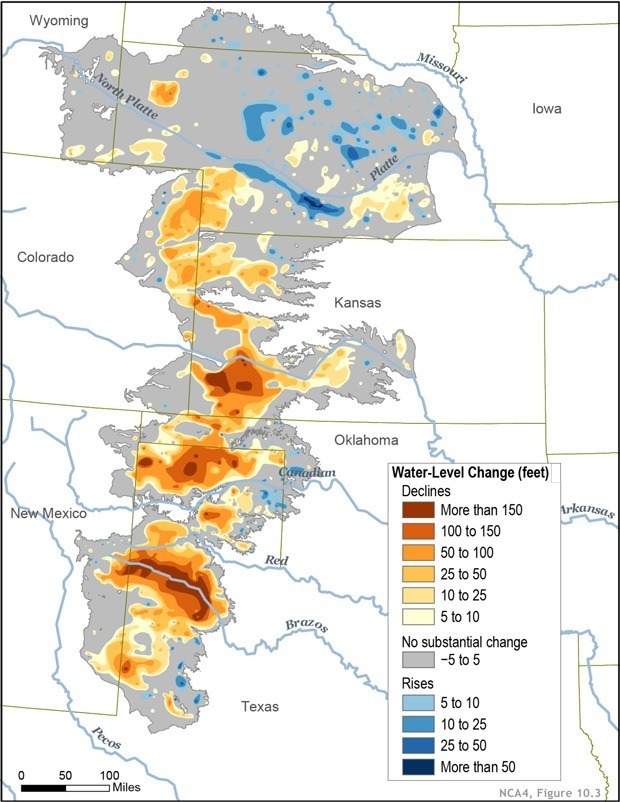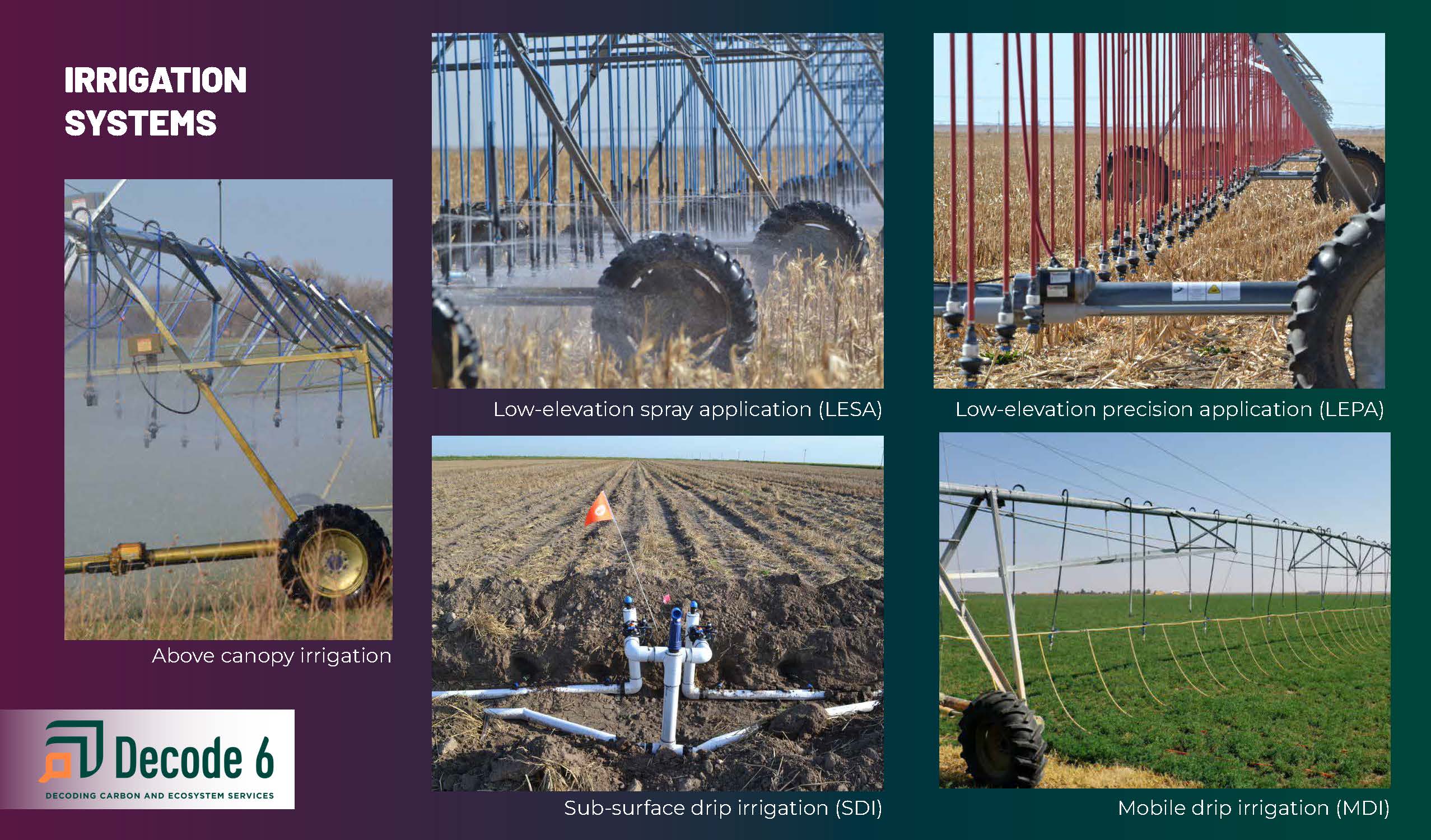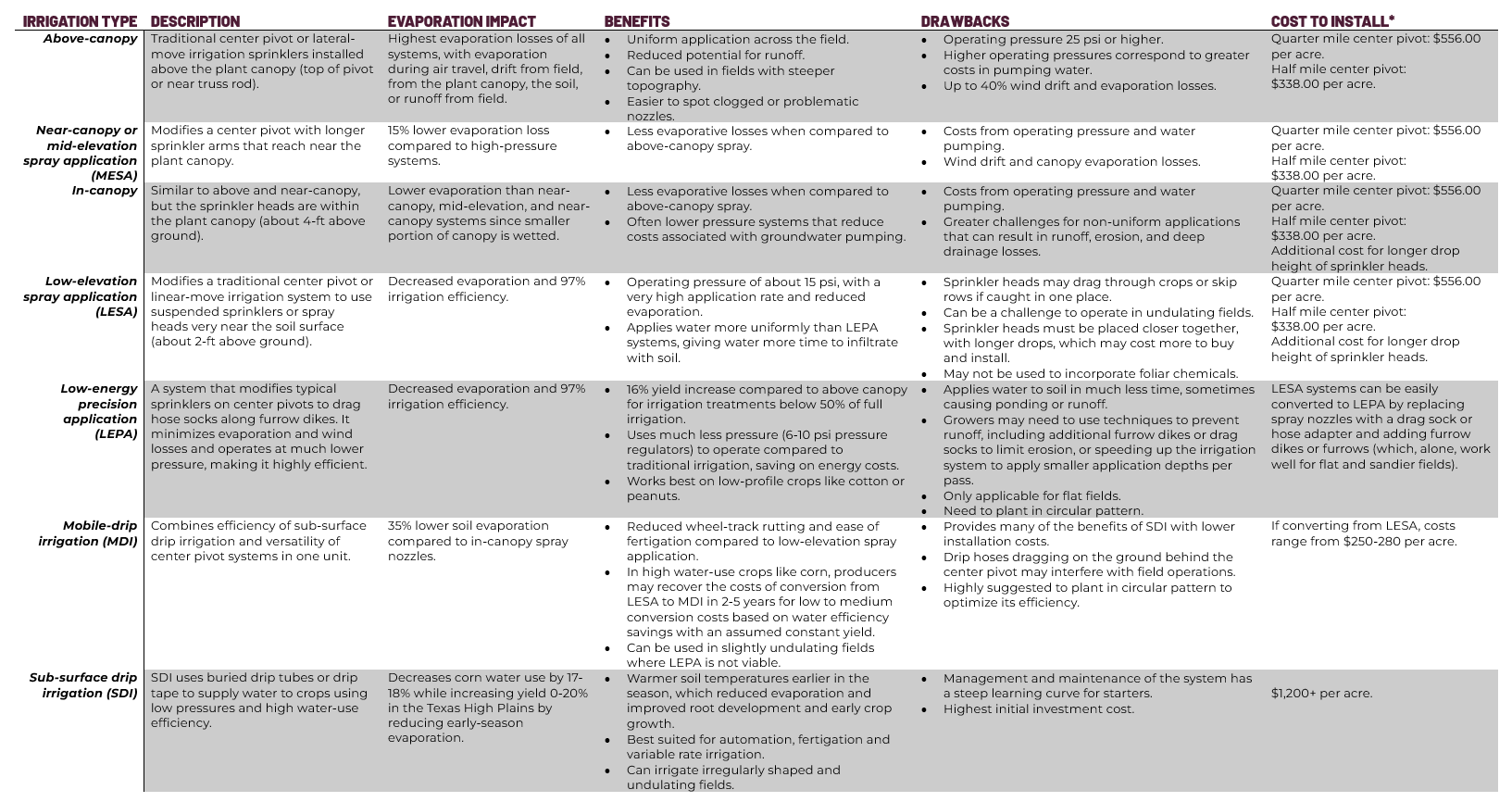How Do I Conserve Groundwater While Irrigating?
This article is adapted from the review article “Policy Technology, and Management Options for Water Conservation in the Ogallala Aquifer in Kansas, USA” published December 2, 2021 in Water.
The short answer: Groundwater is a finite resource. Conserving water while irrigating comes down to matching water applications to crop water requirements, effectively utilizing precipitation, preventing water from evaporating, applying water when it’s needed most, including lower water-use crops in your rotations, and exploring deficit irrigation strategies.
- Groundwater—water stored in the pores and fractures in rock, gravel, and sand—makes up about 39 percent of the water used for agriculture in the U.S.
- If groundwater is available in a large enough amount that you can pump it from below the earth’s surface, it’s known as an aquifer. Aquifers like the Ogallala are critical sources of irrigation water for agriculture in areas where rainfall isn’t enough to grow crops.
- Groundwater pumping is outpacing groundwater recharging, meaning that water sources below the surface of the earth are quickly depleting.

Changes to the Ogallala Aquifer since 2015, mapped by color. Declining levels appear in red and orange, and rising water levels appear in blue. Gray areas showed no significant change. The market value of agricultural products produced in the Ogallala region total $35 billion in 2007, and climate change and water overuse threaten the viability of those systems. Image courtesy of Climate.gov.
Break it down: When it comes to agriculture, there are five ways that growers can help conserve groundwater.
1. Apply water when crops need it most, being mindful of soil water capacity.
-
- Soil water capacity is the amount of water that a field’s soil can hold for plant use. Field capacity refers to the total amount of water a field can hold before drainage occurs—it’s considering soil water capacity across the entire field. The soil water capacity of every field is influenced by its soil texture, soil organic matter, and compaction. You can’t change your soil’s texture, but there are lots of ways to improve SOM, prevent compaction, or improve compacted soils.
- All crops have critical periods in which they need the most water to grow and produce a crop. Understand these critical periods, and portion water uses to match.
- Once you know your soil water capacity and critical periods for irrigation, take care to only apply water when it is most needed. If rain is in the forecast, wait for this free water and do not oversaturate the soil beyond field capacity—water lost to drainage and runoff is water (and nutrients) that plants can’t use.
- Use irrigation scheduling tools whether it is looking at the soil (i.e. soil sensors), and/or weather (i.e. ET-based scheduling) and/or crop (e.g. thermal, dendrometer) to know when to apply that water.

Irrigation systems listed clockwise from most evaporative water losses to least beginning with above canopy irrigation. All photos courtesy of the Irrigation Team, K-State Research-Extension.
2. Improve irrigation efficiency. Make the most of your groundwater by preventing it from evaporating. Any irrigation improvement that gets more water to the roots of the plant and prevents evaporation and runoff will increase water use efficiency, helping protect a precious and finite resource.
-
- In-canopy or near-surface irrigation systems prevent evaporation by decreasing the amount of water flying through the air, landing on the plant canopy, or landing outside of the field when it’s windy. See the table (below) for a comparison of common irrigation systems and their impact on evaporation.
- Sub-surface drip irrigation is even more efficient than near-surface or in-canopy irrigation, since all of the supplied water is delivered directly to plant roots. But it’s also an expensive transition to make, and not suitable for all crops. When looking to increase water use efficiency, balance the cost to change to new irrigation systems with your needs on farm can mean that’s not the best option for you.
- For example, when maintaining or updating your irrigation system (as the NRCS recommends you do every 10 years), explore options that bring sprinklers or nozzle heads closer or into the canopy.

Table 1. Cost, benefit, and precipitation loss comparison of common irrigation systems. Cost estimates for all irrigation systems but MDI sourced from “Economics of Irrigation” by Texas A&M AgriLife Extension: https://itc.tamu.edu/files/2019/12/B-6113.pdf. MDI cost from O’Shaughnessy and Colaizzi, 2017: https://doi.org/10.3390/agronomy7040068.
3. Explore deficit irrigation. Deficit irrigation is a technique in which farmers increase the productivity of water, making water use more efficient.
-
- Deficit irrigation balances tradeoffs: rather than aiming for the greatest possible yield, deficit irrigation seeks to grow as much as possible with limited water.
- In practice, deficit irrigation means that farmers are supplying less water than plants lose through evapotranspiration and the soil loses through evaporation. When paired with practices like conservation tillage, it can help maximize water use efficiency.
- Many plants can tolerate getting less water than needed and some plants even adjust to these drier conditions without significant yield reduction.
4. Replace high water-use crops with lower water-use crops that work better under deficit irrigation.
-
- Substituting sorghum for corn silage can help extract water from deeper in the soil profile and produce greater yield than corn with much higher water use. The forage quality of higher-yielding sorghum and its residue can be a good substitute for high-water use corn.
- Pearl millet is another great low water-use grain option that is highly drought-tolerant and makes a good livestock feed.
- Triticale, cotton, sunflower and other suitable crops may use less water or have different timing for their peak water use compared to your traditional crop rotation. These are good options for areas with limited water supply. Plus, triticale makes a great high biomass, low water use harvested forage for livestock.
5. Explore new innovations in automated sprinkler systems, precision application, and soil water monitoring.
-
- Precision irrigation and sprinkler automation systems use GPS location guidance systems, soil and crop mapping to help apply water when and where it’s needed.
- These systems account for the variations across a field—some areas may dry out faster than others, leaving less water in the soil. Coupling precision irrigation with the other techniques listed above could boost water use efficiency even further.
- Tools that monitor soil water potential is another innovative technology that can help farmers understand what’s going on in their fields. Though traditional soil moisture sensors can be helpful for understanding whether a soil is wet or not, measuring soil water potential can be a great way to understand how the wetness of the soil impacts plant available water.
- While exploring new technologies, don’t forget to maintain your existing equipment. There are minor adjustments that may be keeping your equipment from being the most efficient or may be costing you more (e.g. pumping energy cost).
In short, groundwater is a finite resource. With unpredictable weather patterns and a changing climate, finding ways to make the most of our water resources is imperative. Even small changes to your irrigation regime can make a big difference when it comes to getting water to plants when they need it the most.
Photo by Joel Dunn on Unsplash.








